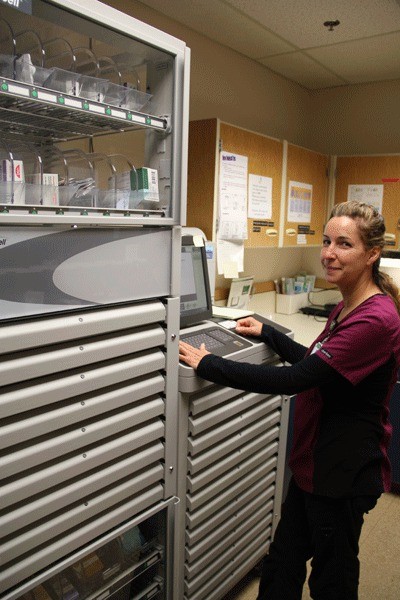She types in her password and swipes her finger across the reader.
For the rest of her shift, the electronic device will accept Cherie Post’s fingerprint as a way to access the medications contained within the clear rectangular cabinet and she will not have to re-enter her password. Post is a certified pharmacy technician at Whidbey General Hospital in Coupeville.
This new system lets Post dispense the medications her patients need quickly and accurately.
“We are always concerned with preventing errors in medication administration,” said Trish Rose, spokesperson for Whidbey General.
The Whidbey General Hospital Foundation secured a $150,000 grant from the Murdock Foundation to help cover part of the $315,000 cost.
The hospital purchased six devices for use in different areas of the hospital. Each device is filled with medications specific to that department’s needs.
Nurses who transferred to Whidbey General from other facilities had a leg up in learning how to use this technology, said Post, who trained her co-workers to use Omnicell. Many were already familiar with a competitor, Pyxis MedStation, which operates in a similar fashion, she said.
For nurses who began their career at the local hospital and had never been exposed to automated medication dispensing, the learning curve was much steeper.
“It was quite the learning experience,” Post said. “There are always growing pains with something new, but we are working through them.”
The hospital continues to make improvements based on feedback from staff to make the dispensing cabinets the most useful tool possible, said Linda Gipson, the hospital’s chief nursing officer.
Younger nurses who are part of the “technology” generation also adapted quickly to the new devices, Post said
Post said she is enthusiastic about this new technology, especially once Meditech comes online, which is the “other piece of the puzzle.”
The Bedside Medication Verification system to be implemented with Meditech assures that medications are delivered correctly each and every time they are prescribed.
Meditech and the verification system should be online next spring.
At the bedside point of medication administration, the nurse will be able to scan the barcode on the patient’s wristband and on the medication to make certain the medication is the correct drug, in the right dose for the right patient, in the right amount and using the right route, Gipson said.
“From the physician’s order to the pharmacy to the Omnicell dispensing system and finally to the administration of the medication at the patient’s bedside every process is designed to assure patient safety and confidence,” Gipson said.
High alert medications, like blood thinning Coumadin, do not have a spot in Omnicell.
Medications that could put patient safety at risk if inappropriately given continue to be dispensed by a pharmacist.
In addition to improving patient safety, the automated system assures that patients are correctly billed for the exact dose of medication that they receive at the time it is dispensed.



